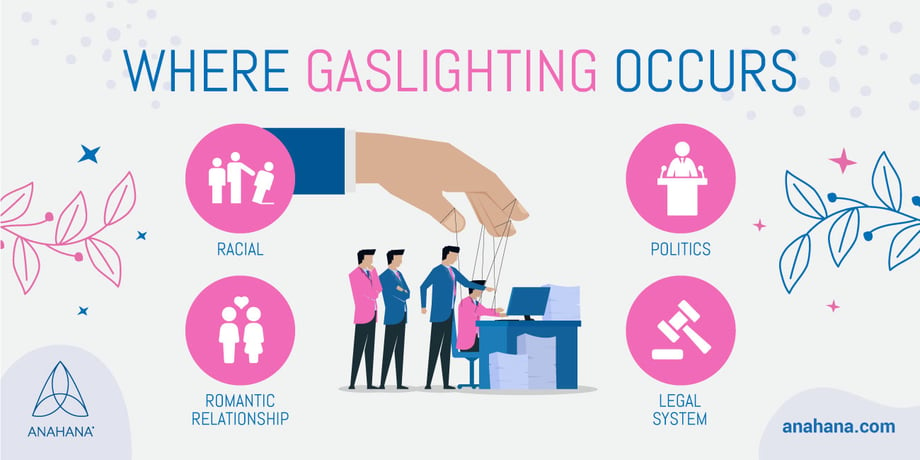
Table of Contents
Learn about the subtle yet damaging psychological abuse called gaslighting.
Discover what it is, where it comes from, and how to recognize if you or someone else is being subjected to it.
Definition of gaslighting
According to the American psychological association (APA), gaslighting is a form of psychological manipulation or emotional abuse over an extended period that makes individuals question their thoughts, judgment, and perception of reality. It most commonly occurs in abusive relationships, leading to a false narrative that makes an individual feel confused and unsure about their mental and emotional stability.
Manipulative people who gaslight others do so to attain control and power over their victim financially, emotionally, or physically. These individuals might have mental health disorders, including childhood trauma or narcissistic personality disorder.
While gaslighting is more common in romantic or intimate relationships, it can also occur in workplace relationships or with family members.
Background behind gaslighting
The term "gaslighting" comes from the title of a 1938 play, “Angel Street,” set in the Victorian era, where a husband manipulates his wife to convince her that she is mentally unstable.
The manipulative husband does this by subtly changing her surroundings, including steadily dimming the gas lamp's flame. He also abuses and controls his wife, cutting her off from friends and family.
The wife begins questioning her thoughts, feelings, memories, and perceptions. She feels hypersensitive, out of control and neurotic, which are common goals of gaslighting.
The film accurately portrays toxic and controlling actions used by manipulative individuals.
Consequently, counselors and psychologists labelled this behavior using the term gaslighting to reference a psychological manipulation tactic. The term was also used later in the film "Gaslight" by Alfred Hitchcock.
Why do people gaslight?
The goal of gaslighting is not just manipulation but also exerting control and power over the victim, using the victim’s misguided help. This behavior is rooted in personality disorders and psychopathy, such as borderline, antisocial and narcissistic personalities.
Gaslighting often begins in relationships that start well. The abusive partner might praise the victim when they first meet, including how much they love the victim, e.g., stating that they are soulmates or twin flames, and their positive qualities and immediately confide in them. This tactic is known as hoovering. Before intimacy has been established, such disclosure establishes trust quickly, a tactic known as love bombing.
The more quickly an individual becomes enamored, the more quickly the next phase of manipulation and gaslighting begins.
A major goal of the abusive partner is to keep the person hooked. If the victim questions or disagrees with their abuser, the abuser may try to make themselves seem as if they are the ones being victimized by their targets.
Gaslighters might not always act with malicious intent or might not realize that they are gaslighting another individual. They often engage in such behaviors due to their upbringing or different beliefs.
Gaslighting abuse in society and at work
 Individuals must recognize the symptoms of gaslighting abuse in romantic relationships, with their abusive partner, and in the workplace or society. Blame-shifting in relationships or other gaslighting can also occur between colleagues, supervisors and employees.
Individuals must recognize the symptoms of gaslighting abuse in romantic relationships, with their abusive partner, and in the workplace or society. Blame-shifting in relationships or other gaslighting can also occur between colleagues, supervisors and employees.
Typically, the abuser acts in a manner that makes the victim question their perspective on the situation, undermining their personal beliefs, values, and self-esteem.
The person might use gaslighting to avoid admitting mistakes at work or unfairly taking credit for tasks that are done well.
Another type of workplace gaslighting is called “whistle-blower gaslighting.” In this situation, an employee who reports a toxic environment, misconduct, or sexual harassment at work is made to feel they are misinterpreting, misremembering or overreacting.
Gaslighting can also be perpetrated against disempowered or marginalized groups in the workplace. For example, gaslighters may try to deny or dismiss their colleagues’ identities or experiences. Peer-reviewed studies in the American Sociological Review involving women of color found that they had negative workplace experiences, including gaslighting.
Types of gaslighting
Gaslighting can occur in various settings and relationships. For instance, in child-parent relationships, abusive caregivers of children, most likely their parents, may gaslight children or abuse them. In addition to the context of families and friends, gaslighting can also occur in other contexts.
Medical and racial gaslighting
Another type is medical gaslighting, where a medical professional dismisses an individual’s concerns about their health as the product of the individual’s imagination or labeling them a hypochondriac.
Racial gaslighting is when the person applies gaslighting techniques to an entire ethnic or racial group to devalue or discredit them. A person or institution might label activist campaigns for change as being irrational. Racial gaslighting also occurs in the workplace, mainly when it is white-dominant.
More recently, the All Lives Matter movement has been an example of racial gaslighting. The movement disguised the prioritizing of white lives, undermining the centuries of dehumanization and brutalization of black people.
Gaslighting in politics and the legal system
Politics gaslighting occurs when political entities or politicians use gaslighting as a tactic for manipulation to gain support for or against a certain viewpoint or to divert public discourse.
Gaslighting can also occur in the legal system. Judges, juries or police officers may unknowingly participate in gender-based gaslighting. When abusers gain control and power of the narrative, the legal system becomes a crucial site of gaslighting.
They alter narratives and stories and draw on stereotypes, especially about black women as aggressive and irrational, thereby engaging internationally or unintentionally in gaslighting tactics, setting themselves up for a loss of credibility.
Gaslighting in romantic relationships
Gaslighting is a specific form of emotional abuse that can occur in romantic relationships. It is a behavior used by one partner to manipulate the other, by making them doubt their own feelings and perceptions.
The gaslighting partner might deny the validity of the victim's emotions, make them question their memories, or turn their experiences around so that the victim has to defend themselves.
Gaslighting not only damages trust in a relationship, but it can also lead to low self-esteem and an inability for one to recognize if they are in an abusive relationship or not.
Gaslighting occurs when love is used as a weapon to control and manipulate instead of being a source of honest dialogue and respect.
It is important that gaslighting is identified and addressed early on since it can have long-lasting effects on individuals, causing deep psychological distress.
How does gaslighting work?
Gaslighting is a technique that undermines an individual’s perception of reality. Gaslighting behavior involves lying and distortion that makes individuals second guess themselves, their events, perceptions, and memories.
Individuals who engage in gaslighting are often pathological liars that exhibit narcissistic tendencies. They can blatantly lie and alter stories despite being called out with evidence, making individuals second guess their own perceptions and their own feelings.
Gaslighters also discredit individuals by spreading rumors and gossiping about others. They might tell others that an individual seems emotionally unstable and crazy and that they are worried about the individual.
This tactic can prove effective because individuals empathize with the abuser without hearing the whole story, thus perpetuating and spreading a certain story about the victim.
The person with gaslighting behaviors can also tell their victims that others think the same way about them despite there being no truth in what they say, further making an individual question their perception and reality.
Individuals who gaslight often change the subject when they are called out or ask the individual another question instead of responding to the question directed to them. This behavior disrupts the individual’s train of thought and results in the individual questioning themselves for bringing up the subject. Individuals may also think that they have a bad memory.
Gaslighters often trivialize an individual’s emotions to gain power over individuals. They might tell the individual to calm down or that they are too sensitive or overreacting. These statements minimize the individual’s feelings and make them question how they express their emotions.
Blame-shifting and denying wrongdoings are other common gaslighting techniques. They often minimize their words or hurtful behaviors by labeling them as jokes or making the victims feel as if they are too sensitive. The person may also deny certain events or behaviors, making the victim question their memory or feel confused.
Common gaslighting behaviors
Gaslighters can use various techniques to achieve their goals and gaslight others. Some techniques the person might use include forgetting and denial, blocking and diverting, countering, obfuscation, withholding and trivializing.
Forgetting and denial involve pretending to forget events that occurred in reality. The manipulator or abuser might delay or deny important promises made to the victim. The gaslighter does this regularly and may create artificial barriers to enable themselves to delay or deny.
Blocking and diverting is a technique in which the gaslighter diverts the conversation from the subject at hand to control the conversation and question the victim’s thoughts.
Countering is when the abusive partner questions the victim’s memory despite knowing that the victim remembers correctly. Obfuscation is deliberately overcomplicating or muddying an issue to puzzle the victim.
Withholding and trivializing mean that the abusive partner pretends not to understand the victim’s thoughts, feelings, and emotions or makes them believe they are unimportant. The abusive partner makes the individual feel they are making a big deal out of the situation, making them question their feelings.
Signs of gaslighting
Being gaslighted can result in mental illness and other mental health concerns, including anxiety, depression, addiction, and suicidal thoughts. Therefore, individuals need to recognize when they are being gaslighted, especially by an abusive partner or a family member.
Some common signs of gaslighting include doubt, questioning judgment and perceptions, being afraid of speaking up or expressing emotions, feeling vulnerable and insecure, feeling threatened, confused, alone and powerless, and spending time apologizing for actions.
Individuals who experience gaslighting are constantly disappointed by themselves, feeling inadequate and incapable of making decisions due to a distrust in one’s self and constant questioning of their sanity.
They might be making excuses for their partner's behavior in front of their friends and family for their partner’s behavior, and individuals tend to withhold information from their loved ones.
Gaslighting and mental health
 Individuals constantly told that they are confused, wrong, or insane may deal with negative consequences on their mental health. Gaslighting victims question their own reality and beliefs and often feel isolated and powerless.
Individuals constantly told that they are confused, wrong, or insane may deal with negative consequences on their mental health. Gaslighting victims question their own reality and beliefs and often feel isolated and powerless.
Gaslighting symptoms can include self-doubt, low self-esteem, disorientation and difficulty functioning in social situations, at school or at work.
Consequently, individuals who experience gaslighting are at a greater risk of depression, anxiety, and suicidal thoughts.
Young adults who experienced these mental health conditions before the abuse are more vulnerable to gaslighting, further exacerbating their mental health conditions.
Individuals who leave an abusive relationship after experiencing gaslighting may suffer from post-traumatic stress disorder (PTSD) and have difficulty trusting others and themselves. Therefore, they might struggle with building connections and engaging in codependent relationships.
As gaslighters do not acknowledge their wrongdoings, it is more difficult for the victims to move on from the experience, making them susceptible to mental health challenges.
Gaslighting can have long-lasting consequences on the victim’s mental health and can result in irreversible psychological consequences.
Difference between manipulation and gaslighting
While there might be similarities between manipulation and gaslighting, as manipulation is a key part of gaslighting, there are clear differences. Manipulation is a common tactic that almost everyone can employ, while individuals who gaslight are relatively rare.
Children can try to manipulate parents at a young age; marketers aim to manipulate consumers. In contrast, gaslighting involves a pattern of manipulation and abusive behaviors with the intent not just to influence the victim and exert power and control over them.
Response to gaslighting
If someone feels like they are experiencing gaslighting abuse in any form or relationship, they must take the necessary steps to protect themselves from this emotionally abusive behavior. Individuals must first understand what is happening and identify the problem.
Individuals can avoid gaslighting by maintaining distance from gaslighters, stepping back from the intense emotions evoked by gaslighting and using relaxation techniques such as meditation or deep breathing exercises.
Individuals must also set boundaries and make the other person realize that their behavior is unacceptable to avoid constant self-doubt. Sometimes, the most effective way to deal with gaslighting is to end the relationship. Getting an outside perspective from a family member or a trusted person can help the victims make the right decision.
Talking to a mental health professional about the situation to develop coping strategies and gain perspective can also be helpful. Greater awareness regarding gaslighting abuse and what it entails can also help individuals avoid unhealthy relationships.
Contacting the national domestic violence hotline or the national sexual assault hotline can also assist individuals experiencing emotional abuse, domestic violence, sexual aggression and gaslighting.
References
What is gaslighting? Examples and how to respond - Medical News Today
Gaslighting | Psychology Today
The hidden victims of gaslighting - BBC Future
Gaslighting: Signs You’re Suffering From This Secret Form of Emotional Abuse - Healthline
Disclaimer
The contents of this article are provided for informational purposes only and are not intended to substitute for professional medical advice, diagnosis, or treatment. It is always recommended to consult with a qualified healthcare provider before making any health-related changes or if you have any questions or concerns about your health. Anahana is not liable for any errors, omissions, or consequences that may occur from using the information provided.

By: Anahana
The Anahana team of researchers, writers, topic experts, and computer scientists come together worldwide to create educational and practical wellbeing articles, courses, and technology. Experienced professionals in mental and physical health, meditation, yoga, pilates, and many other fields collaborate to make complex topics easy to understand. Anahana is also home to specialists in crystals, tarot, angel numbers, astrology, life path numbers, zodiac signs, and horoscopes. By combining evidence-based wellness with spiritual and energetic practices, the team offers clear, trustworthy guidance for both mind-body health and modern spirituality.